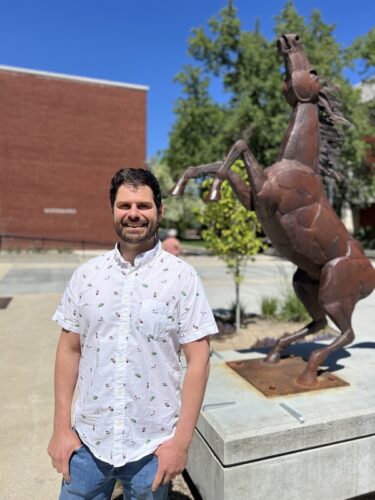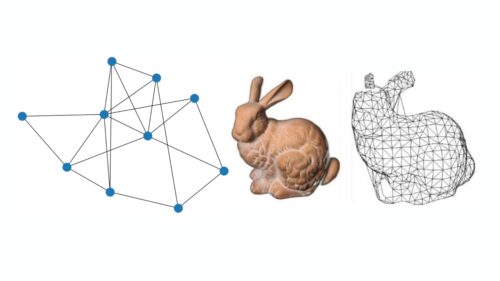
Michael Perlmutter is a traveler. After earning a bachelor’s degree at Tufts University in Massachusetts, he moved to Indiana to complete master’s and doctoral degrees at Purdue University. After pursuing postdoctoral positions at the University of North Carolina at Chapel Hill, Michigan State University, and the University of California, Los Angeles, he’s lived in just about every corner of the United States. Now he’s landed in Idaho.
“A few things stood out the moment I got off the plane and just took a look around,” he said. “Boise was obviously incredibly beautiful. The view of the mountains from the hotel they had me staying at, I was just like ‘wow!’ And then also the people in the department were extremely friendly. There were generally good vibes all around.”
Perlmutter joined Boise State in August 2023 as an Assistant Professor in the Department of Mathematics. He is also affiliated with Boise State’s Computing doctoral. program, and he will serve as a data science consultant on the modeling team for the state’s new $24 million I-CREWS project, which aims to address the impact of climate, population and technological change on energy-water systems in Idaho.
The following interview with Perlmutter has been edited for length and clarity.
Why Boise State?
One of the things that struck me here was the really strong emphasis on interdisciplinary work. I’m trained as a pure mathematician, but I’m increasingly interested in applications to different fields. The doctoral program in computing here is directly interdisciplinary – they have math people, a lot of computer science people. There’s electrical, civil, mechanical, and biomedical engineers, even people from physical chemistry, biology, geosciences, and human-environment systems.
It really stood out that this is not something that Boise State just pays lip service to. This is actually something that is baked into the university.
Everybody says, “we’re going to break down traditional disciplinary barriers in academics,” but at Boise State it was directly structured into the interview in a really concrete way. I met with people from three or four different departments. I met with an ecologist who said, ”I have this project related to deep learning, doing computer vision for drone data, trying to understand the wildlife in Idaho. If we’re hiring somebody on deep learning, I’m going to want to be working with you on that.” And – fast forward – now we are.
Why is interdisciplinary collaboration so important to you?
When I learn about new science problems, I start thinking about how I can solve these with mathematical methods. And this facilitates a virtuous cycle where we use math problems to solve science problems, which leads to new math problems. Ideally we get a nice loop.
Let’s get into your work. How does math fit into the machine learning and artificial intelligence landscape?
Advances of machine learning have been well publicized on the news. There’s been tremendous progress in artificial intelligence over the past decade, and a lot of this is in a situation where practice might be ahead of theory. I see the role for the mathematical community being to help with developing a theoretical understanding of these algorithms, of their limitations, of their potential dangers, and also ask, “how can we design them in intelligent and elegant ways?”

So what do you work on?
A: I tend to focus on data which has structure.
You can imagine something like image data – an image with pixels – and these pixels are arranged in a regular grid where they’re all just nice and equally spaced. The types of machine learning algorithms and neural nets that have been most popular for these are called convolutional neural networks. And, roughly speaking, they’re designed to take advantage and exploit and utilize the structure of the data – this nice regular grid-like format.
I’ve worked more on data with an irregular geometric structure. So this could be like a curved surface, where you want to take advantage of the geometry of the curved surface and build that into your model. Another example is network data, where you could visualize a bunch of dots, and lines between the dots where those lines indicate that two objects are somehow connected. In both of these cases, what I want to do is try to design machine learning methods which are going to utilize the intrinsic structure of the data rather than superficial artifacts.
What are superficial artifacts and why are they an issue?
A: Say we were trying to look at surfaces of the human body, and we were trying to predict something about that, like recognize a given person. If you were to rotate that person, that would be thought of as a superficial artifact. If I rotate around, I don’t magically become a different person. So you’d want to develop algorithms which are somehow unaffected – the math term we like to use is invariant – to these uninformative deformations which we would want to somehow not factor into our analysis.
In broad terms, I-CREWS is about studying energy-water systems. How does data science fit in?
Traditional hydrological studies have relied on mathematical and computational models of how the relevant physical systems work.
In physics class, you learn that ‘force is equal to mass times acceleration.’ That is pretty darn concrete. And there’s no need for data science for something like that, where there’s a well-understood governing physical law.
The problem is that real world problems are often messy. And where data science tends to work well is when there’s not a canonical physics equation for it. So what data science can do is, rather than trying to start from a top down physical model of how it all works, we try to take our observations and detect the patterns in that. So it can be complementary to the more traditional physics based models.
Do you have any personal goals for your role on the I-CREWS project?
I’m hoping to be able to assist the other members of the modeling team in furthering their objectives, I think my math background is largely complementary to the existing skill sets. This is also an exciting opportunity to learn more about hydrology since this is something that’s new to me.
There’s kind of this misconception that some people might have which is that you’ve got your doctorate and this is the last degree you can get, so now you’re the expert. That could not be further from the truth. I’m constantly learning new things and branching out to new areas as well as trying to keep up with the existing literature. And this is really an exciting opportunity to branch out into a new area and to work with people from a wide variety of backgrounds.
-Story and photography by Elise Overgaard